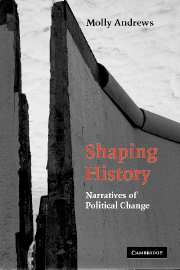Book contents
5 - East Germany: the contested story
Published online by Cambridge University Press: 15 December 2009
Summary
The fact that in the one and only democratic election in the existence of the German Democratic Republic (GDR), citizens voted to dissolve their country is the stuff of classic tragedy. The revolution eats its children, we are told, and so it happened in East Germany in 1989. Sebastian Pflugbeil, a leading East German opposition activist, voiced the fallen hopes of many which followed in the wake of his country's revolution: ‘We have helped give birth to a child that quickly turned into a rather ugly creature’ (Philipsen 1993: 161). East Germany has been the subject of countless publications since its demise more than fifteen years ago; yet still there is no consensus on the meaning of the changes which occurred there in its ‘spring in winter’ (Reich 1990).
In March 1990 I heard Jens Reich give a lecture at Cambridge University on the upcoming elections in East Germany. The research questions which I pursued over the following few years directly stemmed from what I heard on that day. In the months preceding his talk, Reich had become a familiar face to many. He was one of the founding members of the East German political group Neus Forum (New Forum) which had spearheaded many of the changes of that momentous autumn. Reich was a microbiologist with an international reputation, and a well-known public figure in East Germany.
- Type
- Chapter
- Information
- Shaping HistoryNarratives of Political Change, pp. 114 - 147Publisher: Cambridge University PressPrint publication year: 2007

